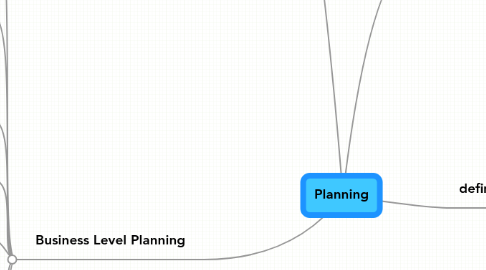
1. The corporate planning process
1.1. a) Defining mission
1.1.1. sets the direction (invisible guiding hand)
1.1.2. the general business operation of the mission statements guides the organisation
1.1.3. shaped by
1.1.3.1. history
1.1.3.2. preferences
1.1.3.3. PEST
1.1.3.4. recources
1.1.3.5. distinctive competency
1.2. b) setting objectives and goals
1.2.1. 7 areas of long term objectives
1.2.1.1. 1) profitability
1.2.1.2. 2) productivity
1.2.1.3. 3) competitive position
1.2.1.4. 4) employee development
1.2.1.5. 5) employee relations
1.2.1.6. 6) technology leadership
1.2.1.7. 7) public responsibility
1.2.2. The long term qualities usually:
1.2.2.1. acceptable, flexible, measurable, motivating, suitable, understandable and achieveable
1.3. c) designing the business portfolio
1.3.1. Use the BSG Matrix
1.4. d) New-business plan
1.4.1. aim = to close strategic planning gap
1.4.1.1. the difference between projected sales and desired sales
1.4.1.2. How to close the gap?
1.4.1.2.1. 1) Achieve growth in the company's current business
1.4.1.2.2. 2) Find opp to acquire business that are related to the company's current business
1.4.1.2.3. 3) id opp to add attractive businesses that are related to the company's current business
2. Business Level Planning
2.1. Business Mission
2.1.1. Guides the business activities of the BU and SBUs within the framework of the corporate mission
2.2. External/Internal analaysis
2.2.1. External
2.2.1.1. SWOT - Strength, Weakness, Opportunities, Threats
2.2.1.1.1. Provides a base for auditing and troubleshooting
2.2.1.1.2. Design and convergent & matching strats
2.2.1.2. PEST
2.2.1.3. Porters 5 forces model
2.2.1.3.1. useful for firms to determine the attractiveness or strength of the competition in the industry
2.2.2. Internal
2.2.2.1. Identify Strengths & Weaknesses
2.2.2.1.1. Use BCG Matrix
2.2.2.1.2. Porters's Value Chain
2.3. Good formulation
2.4. Strategy formation
2.4.1. Company can think of 3 strategies or it can choose 1 or all of them to pursue.
2.4.1.1. 1) focus strategies -> specialised, niche group
2.4.1.2. 2) low-cost leadership
2.4.1.3. 3) differenation
2.4.1.3.1. trying to be the 'extra' to vie for customer loyalty
2.5. Programe evaluation
2.5.1. a time table for implementation
2.6. Implementation
2.6.1. 7-S Framework by Peters & Waterman
2.6.1.1. Hardware
2.6.1.1.1. Strategy
2.6.1.1.2. Structure
2.6.1.1.3. Systems
2.6.1.2. Software
2.6.1.2.1. Style
2.6.1.2.2. Staff
2.6.1.2.3. Skills
2.6.1.2.4. Shared Values
2.7. Feedback and Control
2.7.1. can be determined by
2.7.1.1. 1) Mkt share
2.7.1.2. 2) Sales
2.7.1.3. 3) profits
2.7.2. If the objective is not achieved
2.7.2.1. then implement corrective measures such as Promotions or Change in product design
2.7.3. If all still fails, then diversify into another business
3. defination
3.1. planning is considered to be the most basic managerial function
3.2. sets the direction for organisating, leading and controlling functions
3.3. establishes rationale
3.4. defines goals and objectives for future performance and how to reach them
3.4.1. a) choosing organisation mission and objectives for short run and long run
3.4.2. b) divising objectives for different levels of control and hierarchy level
3.4.3. c) choosing the suitable strategy and tactics to achieve objectives
3.4.4. d) deciding on the allocation of resource to the strategies
4. Strategic vs Tactical vs Operational Planning
4.1. INSERT TABLE HERE
4.2. Strategic Planning
4.2.1. Long Term
4.2.2. Set general directions for the whole organisation
4.2.3. Top most management (band of directors)
4.2.4. affects the whole organisation
4.3. Tactical Planning
4.3.1. Responsibility of the middle management
4.3.2. incharge of various deparments
4.3.3. Sync with other departments
4.3.4. Carry out the strategies prepared by the top management
4.4. Operational Plannings
4.4.1. appointed by lower management
4.4.2. usually supervisors
4.4.3. allocate duties to staff that are under their chain of command
